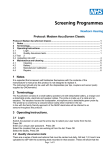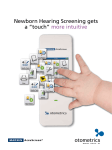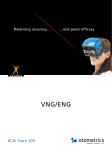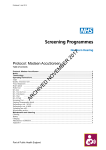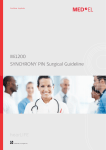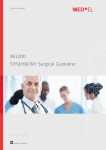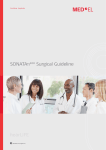Download FAQ - GN Otometrics
Transcript
FAQ www.icsimpulse.com FAQ Question Why is ICS Impulse superior to Visual Observation? Answer • ICS Impulse can identify covert saccades • Validates that the head impulse is performed properly • Both sensitivity and specificity are 95% for ICS Impulse. Sensitivity is estimated at 70% for visual observation* • Reduction in false negative (identifying patients as normal who are truly abnormal) • Objective Analysis with normative data • Documented head impulse test results • Better patient comfort during testing because smaller head impulses can be used (150 -200 deg/s) with superior diagnostic accuracy. * Weber KP, Aw ST, Todd MJ, McGarvie LA, Curthoys IS, Halmagyi GM. Head impulse test in unilateral vestibular loss: vestibulo-ocular reflex and catch-up saccades. Neurology 2008; 70(6):454-463. How is Head Impulse testing similar and different from Caloric testing? HIT • Ear-specific • Detects in cases of peripheral vestibular loss in Lateral SCC – LARP/RALP in Anterior and Posterior SCC • Tests at High Frequencies (4-5 Hz) which is stimuli replicating the patient’s everyday situations • Stimulus does not persist between tests Caloric • Ear-specific • Detects in cases of peripheral vestibular loss in Lateral SCC • Tests at Low Frequencies (~0.025 Hz) • Stimulus can persist between irrigations especially if not performed properly How does Impulse assist in performing proper head impulses and making sure only quality data is analyzed? Performing a proper head impulse is important in order to properly diagnosis the patient. Impulse displays training curves that assist in demonstrating how a good head impulse looks. The operator feedback tells you if the head impulse is good or poor. If it is poor it tells you why: too slow or too much overshoot. There are also 2 algorithms that assess if the head impulse is properly performed. If it is not then the head impulse will be rejected. The analysis algorithm looks at both the head and eye movement. If the patient is not staring at the fixation dot the head impulse will be rejected. All of these features ensure that only quality data is represented in the analysis. This increases your comfort in providing a proper diagnosis. Why is it important to calibrate each patient? Why should default calibration only be used if the patient cannot be properly calibrated? If possible you should always perform calibration. If the patient cannot see the laser calibration dots or cognitively cannot perform the task take the default calibration values. Remember, the patient has to be able to see the fixation dot or stare at something during the test. Default calibration value is = 21. Based on 25 patients range 24-51 (left) and 42-73 (right). By using the default calibration, you could be introducing as much as 10% variability to the data collection results. This is why it is important to calibrate the patient if possible; however, this variability is better than not being able to test at all. Why is performing unpredictable head impulses important? Why do we not want the patient to be able to anticipate the head impulse? We do not want the patient to try to compensate for their disorder. Randomizing head impulse direction mainly affects the catch-up saccade pattern. If the head impulses are completely predictable, patients will do better in making covert saccades (compensating). In order to show the deficit (which is the purpose of the test), it’s better to randomize the order. Unless the catch-up saccades are very early (<100ms) they will not interfere with gain measurements. Why am I getting high gain values? High gain values could be one or a result of a combination of the below issues. 1) Slippage of the goggles - make sure strap is very snug, that the cable from the goggles is clipped to the patient’s right shoulder or collar with some slack, and there are not gaps between the foam cushion and the patient’s face. See section 3.4 of the user manual for pics of a good and poor goggle placement. You can access the manual from the bottom left corner of the software. 2) Patient is too close to the fixation dot - If they are closer than 1 meter you will see increased gains due to convergence of the eyes. VOR gains will go up with close distances. Never stand in front of the patient and have them fixate on your nose when using ICS Impulse. This method of testing will result in higher gains. 3) If you have ruled out 1 & 2, it could be that the patient has Meniere’s. See Manzari et al. Rapid fluctuations in dynamic semicircular canal function in early Meniere’s disease Eur Arch Otorhinolaryngol 14 Dec 2010. Why collect varying velocities? Recording of different velocities was interesting from a scientific point of view, because it told us that velocities of about 150-200 deg/s are necessary to detect a unilateral deficit reliably. The only reason for different velocities in clinics is that the 3D plots look much nicer. What is the best velocity to use during testing when trying to identify unilateral deficits reliably? 150-200 deg/s. The lower limit is based on the following publication (figure 2). Head impulse test in unilateral vestibular loss: vestibulo-ocular reflex and catch-up saccades. Weber KP, Aw ST, Todd MJ, McGarvie LA, Curthoys IS, Halmagyi GM. Neurology. 2008 Feb 5;70(6):454- 63. The upper limited was based on experience from the team in the article. The more vigorous the head impulse, the more likely you will get bumps & artifacts with a video goggle system. FAQ Question Answer Why should the patient be 1 meter from the fixation dot? Having a very close target activates convergence, i.e. the eyes have to cross in order to look at the dot. Activation of the convergence system may interfere with the VOR. In addition, a close target adds a linear component, i.e. the eyes moves sideways relative to the dot (this effect becomes smaller with increasing distance of the target). From a technical point of view, there may be some parallax of the laser (relative movement of the laser dot in the field), because it is attached to the right side of the goggles. Therefore it is a good idea to have at least 1 m of distance. What happens if the frame rate drops below 219? If the frame rate drops below 219 during data collection the software will reject that head impulse. A frame rate below 219 is problematic because the data collection will not be accurate (e.g. peak velocity, gain measurements etc). What is the difference between overt and covert catch-up saccades? • Overt – occur after the head movement and can sometimes be seen using visual observation • Covert – occur during the head movement and cannot be seen using visual observation Where did the default normative data cutoffs come from? MacDougal HG, Weber KP et al (2009) The video head impulse test: Diagnostic accuracy in peripheral vestibulopathy. Neurology 73:1134-1141. What is the difference between the collected and accepted data? These are 2 completely separate algorithms. The collected algorithm is on-line (during data collection) and less detailed. These are the numbers that display in the collection window (left/right accepts and rejects) and is displayed in the collected column in the test info window. All the data (not just the collected data) goes thru a second algorithm - the Analysis algorithm and this is more detailed and off-line and the results are displayed in the accepted column in the test info window and what is included in the 2D and 3D analysis. The numbers for the collected and accepted may not always add up to the same number because the raw data is being analyzed twice by 2 different algorithms. Why would the collection number be larger than the analysis? Due to the way impulses are found (peak detection in analysis vs velocity threshold in collection), if the operator performs an impulse with a peak of around 50deg/sec, this impulse will be counted by collection, but may not be counted by analysis. Why would the analysis number be larger than the collection? Collection impulses are 250 samples and analyzed impulses are 175 samples, there is a small window whereby if you perform two impulses quickly between 100 and 200 samples apart, the collection code will see this as one impulse, and the analysis code might see it as two impulses. It is important to perform the head impulse wait and look to verify that your head impulse matches the training curve and the operator feedback is green. Can I export data in a format I can use for research? Yes, you can export patients and choose ASCII Test Results or ASCII Raw Data. ASCII Test Results exports the accepted data shown in the analysis windows. ASCII Raw Data exports all data collected even the data rejected by the collection and analysis algorithms. How many head impulses should I perform? The default is 20. This was recommended by Drs. Halmagyi and Curthoys as a starting point. Once the tester is confident in their ability to perform proper head impulses with very few rejects then this number can be reduced. How large are the video files? See Ch 4 in the manual Video Record/Playback for detailed information on eye video, room video, and combined video sizes. Can you test a patient that has Strabismus? Yes, as long as it’s not a paralytic strabismus. You need to cover one eye (the one that is not recorded) to make sure the patient is always fixating with the same eye. Gain vs 3D Tracing – What should I look at? BOTH! Do not only rely on the gain graph to determine if the patient is within normal limits or has an abnormal VOR response. You must look at the traces. It is easier to see catch-up saccades in the 3D analysis. If the gain is in the normal range but the 3D analysis clearly shows catch-up saccades then the patient is exhibiting an abnormal response. This is sometimes seen with patients where their covert saccades are right on top of the peak velocity of the head trace. See blog posts at www.headimpulse.com to learn more. We tested a patient with right vestibular neuritis but the gain was normal on the left side. Why is this? This is often seen and has been documented in published articles. The VOR gain to the healthy side does decrease a bit but the normal range is large so you don’t detect that decrease. In Manzari L, Burgess AM, MacDougall HG, Curthoys IS Objective verification of full recovery of dynamic vestibular function after superior vestibular neuritis. Laryngoscope; 2001: Rapid Communication. In this article a patient when in attack the VOR gain for the healthy side is ~0.8 (still in the normal range), but on recovery the VOR returned to ~1.0. Why are gains for head impulses to one side higher than to the other side? There can be many reasons for that. The gain of each side can be affected by factors affecting just that labyrinth. There will be natural variations. Another reason is since the data is recorded only from the right eye, it is slightly biased (gains are higher on the right than on the left). Ian Curthoys calculated the asymmetry ratio for 90 healthy subjects (data collected by Manzari with prototype and unpublished) and found that the difference was very small 2.7%. This difference was reported in coils (Prog Brain Res. 2008; 171:195-8. Inter-ocular differences of the horizontal vestibulo-ocular reflex during impulsive testing Weber KP, Aw ST, Todd MJ, McGarvie LA, Pratap S, Curthoys IS, Halmagyi GM. Department of Neurology, Royal Prince Alfred Hospital, Sydney, Australia. [email protected]). In coils the difference was reported at 15%. It is hypothesized that the slower velocity head impulses used with goggles results in a lower difference between leftward and rightward head impulses. This effect most likely arises from physiology. FAQ Question Answer There are 175 samples per analyzed impulse. We take each sample from the start to the zero-cross for the head movement. We sum the amplitudes of each of these samples. This gives us one value for the head. We repeat the process for the eye movement giving us one value for the eye. Gain = eye-sum divided by the head-sum. Note that for the sake of this calculation, the eye tracing is first de-saccaded. In summary, our present gain calculation is based on area under the (de-saccaded) eye velocity vs area under the head velocity. Why do we not tilt the head for head impulse testing so that the semi circular canals will be straight like when one walks. Should we tilt the head to compensate for the angle of the canals? The horizontal canal planes are pitched up just a little in the head (by about 21 degrees - Curthoys et al 1977). So to get them exactly horizontal you would have the head pitched down by 21 degrees. But it does not really matter because the strength of the stimulus decreases as a cosine function of head pitch. So being 20 degrees off has hardly reduced to strength of the stimulus to the horizontal canals. For more information please read and see Figure 2: Curthoys I.S., Blanks H.I. & Markham C.H. (1977) SEMICIRCULAR CANAL FUNCTIONAL ANATOMY IN CAT, GUINEA PIG AND MAN Acta Otolaryngol 83: 258-265. GN Otometrics, Europe. +45 45 75 55 55. [email protected] GN Otometrics, North America. 1-800-289-2150. [email protected] www.otometrics.com www.icsimpulse.com Specifications are subject to change without notice. Copyright © GN Otometrics. 2012/08. 7-26-8801-EN/04. Part no. 7-26-88001-EN. How is Gain calculated for ICS Impulse?






